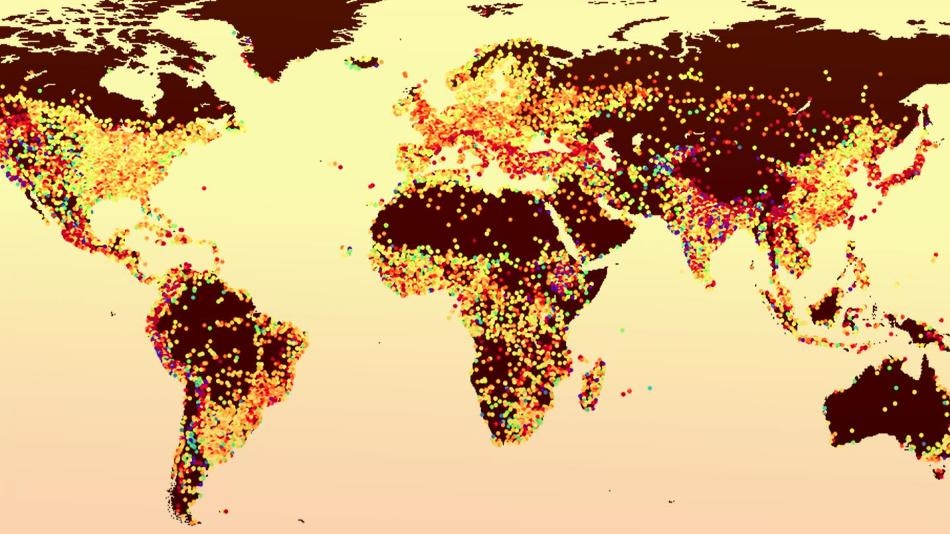Sep 5 2019
During the heat of summer, cities tend to swelter more than neighboring rural areas and suburbs. While the size of this urban heat island effect differs broadly among the world’s cities, heat island intensity can fundamentally be explained by a city’s precipitation level and population, scientists stated in a paper published in the journal Nature on September 4th, 2019.
 (Image credit: Image by Gabriele Manoli. Illustration by Beatrice Trinidad)
(Image credit: Image by Gabriele Manoli. Illustration by Beatrice Trinidad)
Comprehending a city’s heat island effect is crucial for formulating strategies to decrease energy use and fend off hazardously high temperatures, said Elie Bou-Zeid, a professor in Princeton's Department of Civil and Environmental Engineering and one of the study’s authors. The analysis proposes that cooling cities by cultivating more vegetation may be more effective in drier areas compared to wetter ones.
Utilizing the summer temperature data from over 30,000 cities across the world, Bou-Zeid partnered with colleagues at Duke University and ETH Zurich to create a new model for urban heat islands. The model’s novelty is that it uses precipitation and population as proxies for a complicated array of factors involving the environment, climate, and urban engineering.
Simplicity is one of the model’s advantages. Although it cannot measure details of separate cities, it can offer planners a fast and largely accurate view of potential solutions and their effects on the temperature of a city.
“There are a few cities—New York, London, Baltimore—that are studied intensively, and we don't know very much about a large range of other cities,” said Bou-Zeid. “With a reduced model that only needs information on precipitation and population, we are hoping to provide a simple framework that can give guidance to any city” in planning heat alleviation efforts.
The heat island effect, described in the research as the surface temperature difference between rural and urban areas, is slightly larger for cities with more population. One main reason is that these cities tend to have larger areas as well as more multistory buildings that do not dispel heat as efficiently as lower structures.
The scientists also learned that the heat island effect grows as a city’s average yearly precipitation increases, since its surroundings become cooler and greener, but just up to a point. Outside a precipitation level of about 39" (100 cm) per year—akin to that of Washington, D.C.—a city’s temperature boost does not increase much above 2 °F (1.25 °C). This holds implications for methods used for cooling wetter cities.
Although growing vegetation can decrease the temperatures in a city through evapotranspiration, there are restrictions to this method. Southeast Asian cities like Singapore have high precipitation and large areas of green cover, but have robust urban heat island effects because neighboring rainforests certainly contain a lot more plant life than the city. Conversely, drier cities such as Phoenix can be even cooler than neighboring areas in the summer if irrigation is used to cultivate plants in the city.
In places that are already wet and vegetated, adding more vegetation is not going to help.
Elie Bou-Zeid, Study Author and Professor, Department of Civil and Environmental Engineering, Princeton University
Bringing down summer temperatures in these cities will necessitate different solutions, such as increasing ventilation or shading, or constructing with novel materials. Nevertheless, all cities can gain other advantages from green areas, such as opportunities for recreation and better air quality.
Our results show that there is no one-size-fits-all solution to reduce city-scale warming. The efficiency of heat mitigation strategies varies across geographic regions, and any effort aimed at greening and cooling world cities should be put in the context of local hydro-climatic conditions.
Gabriele Manoli, Study Lead Author and Research Fellow, ETH Zurich
Considering that urban areas will face the cumulative effects of global climate change and population increase, these results can offer direction for the climate-sensitive design of future cities.
Bou-Zeid and his colleagues are working to broaden their model to analyze seasonal variations in the urban heat island effect. Their framework could also be used to develop more customized models for particular regions of the world.
In addition to Manoli and Bou-Zeid, the paper’s authors are Simone Fatichi, Markus Schläpfer, Kailiang Yu, Thomas W. Crowther, Naika Meili, and Paolo Burlando of ETH Zurich; and Gabriel Katul of Duke University. The study was partly funded by the National Science Foundation and by a Branco Weiss Fellowship.